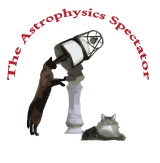
The basic layout of the site is as survey paths, which can be found under the Surveys link at the top of this and most other pages on this site. Each survey begins with a basic overview of the subject. Part of this overview include simulators of astrophysical phenomena that allow the reader to experiment with the phenomena. The later pages in a survey present the subject in greater and more mathematical depth. A path ends with research pages that describe current research projects and results in astrophysics.
The links at the top of each page are Home, which is the current home page of this site, Commentary, which is an index of short essays on topics loosely related to astrophysics, Surveys, which is the index of survey paths, Research, which is the index of research pages and the page leading to recent news items, Background, which is the index page for all background information on astrophysics, including survey pages, simulator pages, tables, bibliographic references, and lists of web resources, Previously, which is an index of previous home pages, and Site Info, which describes the site and its author, and gives contact information.
On the home page is found an addition link. This is the Store link, which leads to reviews of worthwhile books on astronomy and other relates subjects. Links on these pages enable the reader to buy these books from Amazon.com, which helps to financially sustain this web site.
Each Wednesday, a new issue of The Astrophysics Spectator is published that comprises a new home page, a new commentary, whatever news the author notices, and background, research, and simulator pages added to the survey paths. The home page acts as an index to the newly added pages. This site also has an RSS channel, whose link is given at the bottom of the right-hand column of this page.
June 15, 2005
I continue the discussion on x-ray astronomy in this week's edition of The Astrophysics Spectator. The pages added this week discuss what can be learned about a source that emits x-rays and the current observatories that are used to study x-ray sources outside of our Solar System. A background page on the units used to measure photon frequency and energy is also added to the site this week.
X-ray astronomy is the branch of astronomy that studies the hot regions of our universe. These regions are common, found in areas as diverse as the coronas of stars, the surfaces of neutron stars and white dwarfs, and the centers of galaxies. But these regions, while common, were invisible to us until the opening of the space age, when satellites carrying x-ray detectors were placed into orbit around Earth.
The current generation of x-ray observatory has only three members: a satellite carrying timing experiments that measures the variability of x-ray sources, and two satellites carrying x-ray telescopes that create x-ray images of the sky and measure high-resolution x-ray spectra.
Our new-found ability to observe the high-resolution spectra of x-ray sources has opened a new world to the theorist. As in optical spectroscopy, x-ray spectroscopy provides spectra that show atomic emission and absorption lines. While the lines seen with optical spectrometers are created by electrons in the outer energy levels of neutral or lightly-ionized atoms, the lines seen in the x-ray are from electrons in the inner-most energy levels of highly ionized atoms. Observations of these lines give us diagnostics of the conditions at the x-ray source, particularly the temperature, density, velocity, and composition of the gas emitting the x-rays.
The variability of an x-ray source contains a wealth of information, although the precise interpretation of this information in terms of physical processes can be difficult. The most straightforward signatures found in such observations are the variations caused by the rotation of the source or the orbit of the source around a companion. For instance, the spin periods of x-ray pulsars, which are highly magnetized neutron stars orbiting companion stars, are measured by observing the periodic variation of the pulsar's x-ray luminosity. Other types variability, either random or quasiperiodic, contain information about the physical processes taking place in the emission region of x-ray sources.
The background page that I have added explains what the frequency of light represents and relates this measure to the energy carried by individual photons. This page contains a table that expresses various measures of wavelength and energy in terms of photon frequency.
Jim Brainerd
Background
Light and the Measures of Frequency. Astronomers use a variety of measures to express the frequency of a light wave. These units can be in terms of frequency, wavelength, or photon energy. Which of these units is used varies among the various observer communities. This page explains the basic relationship between frequency, wavelength, and photon energy, describes the different units in use, and presents a table relating these different units. This page is listed under the Table link of the Background page. (continue)
Research
X-ray Astronomy. X-ray astronomy opens the hotter regions of our universe to observation. By observing x-rays from a source, we can determine the temperature, density, and composition within the x-ray emission region. We can also measure spin and orbital periods for x-ray sources by observing the variability of the x-ray flux. These observations are possible for a wide variety of sources, including the coronas of stars, the accretion disks around neutron stars and black hole candidates, and the centers of galaxies. (continue)
X-ray Observatories. X-ray astronomy came into its own with the launch of the Uhuru satellite in 1970. Since that time, many x-ray satellites have been placed into orbit. Currently three x-ray observatories dedicated to observing sources outside of our Solar System are in orbit. These are the Rossi XTE, the Chandra X-ray Observatory, and the XMM-Newton. With these satellites, we can measure the variability and spectra of x-ray sources and we can create precise images of the x-ray sky. (continue)

RSS Channel
